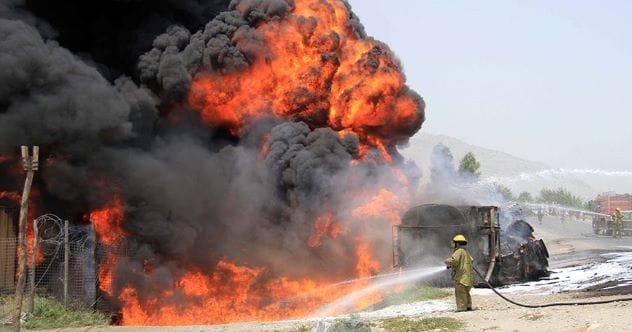Accidents are unfortunately a part of human history, but the industrial age amplified their scale, making workplace accidents far more deadly. While advancements in manufacturing, power production, and transportation have shaped the modern world, they’ve come at a significant cost.
Since the dawn of the industrial era, many industrial accidents were avoidable. Enhanced oversight, stricter regulations, or simply addressing human error could have averted numerous disasters. This list explores ten such accidents where countless lives were tragically lost, highlighting how these disasters could have been prevented.
10. The Port Chicago Disaster: The United States
On the evening of July 17, 1944, a massive explosion lit up the San Francisco Bay Area. The blast originated at the Port Chicago Naval Magazine when a cargo ship loaded with ammunition bound for the Pacific theater exploded.
The explosion killed 320 sailors and civilians and injured 390 others, marking the worst homefront disaster of WWII. The Port Chicago Disaster exposed unsafe working conditions, leading to a revolt by hundreds of sailors who refused to load munitions.
The “Port Chicago 50” were convicted of mutiny and sentenced to 15 years of hard labor and dishonorable discharge. The incident sparked controversy due to perceived discrimination, as nearly two-thirds of the dead were African American. In 2019, the U.S. Congress officially exonerated the court-martialed men.
How it could have been avoided: The disaster was due to unsafe working conditions and inadequate training. Most of the victims lacked proper training in handling munitions, and the rushed schedule increased the likelihood of errors.
9. The San Juanico Disaster: Mexico
On November 19, 1984, a massive explosion devastated the liquid petroleum gas (LPG) tank farm in San Juanico, Mexico. The blasts destroyed the farm and consumed 11,000 cubic meters of LPG, a third of Mexico City’s supply.
The explosion caused widespread destruction in the town of San Juan Ixhuatepec. The estimated death toll ranged from 500 to 600, with 5,000 to 7,000 people suffering severe burns. The San Juanico Disaster remains the deadliest LPG disaster in history.
The explosion was triggered by an LPG leak, likely caused by excess pressure buildup. The resulting vapor cloud ignited upon contact with an open fire, and the explosions were so intense they registered on seismographs at the University of Mexico.
How it could have been avoided: The gas detection system was ineffective. A properly functioning system would have detected the leak, preventing the rupture and subsequent explosion.
8. The Oppau Explosion: Germany
On September 21, 1921, approximately 4,500 metric tons of ammonium sulfate mixed with ammonium nitrate fertilizer exploded, killing between 560 and 600 people and injuring around 2,000 others. Dynamite was used to loosen the chemical mixture from a 66-foot silo, a standard practice done about 20,000 times before.
It was believed that a mixture with less than 60% nitrate wouldn’t explode. However, the mixture wasn’t the expected 50/50 ratio. The dynamite detonated the silo, and the explosion was heard as far as Munich, Germany. Around 80% of Oppau’s buildings were destroyed, leaving thousands homeless.
How it could have been avoided: The conclusion about the mixture’s safety was false. Changes in the manufacturing process had made the substance more explosive, a factor not considered.
7. Courrières Mine Disaster: France
The Courrières Mine Disaster, on March 10, 1906, remains Europe’s worst mining accident. A coal-dust explosion resulted in the deaths of 1,099 miners.
Residents near the mine woke to the massive blast. About 500 of the 1,795 miners escaped, but most suffered severe burns or inhaled toxic mine gases.
The explosion stemmed from a fire that began the previous afternoon in the Cecil Pit. Miners attempted to extinguish it by sealing off the outlets, but fissures released flammable gases, causing a devastating explosion.
How it could have been avoided: The cause of the initial fire is still debated. However, safer Davy lamps instead of naked flame lamps could have prevented the fire and subsequent explosion.
6. The Chernobyl Nuclear Disaster: Ukraine
The Chernobyl disaster, on April 26, 1986, was the most devastating nuclear accident ever witnessed. The No. 4 reactor at the Chernobyl Nuclear Power Plant in Pripyat, Ukraine, resulted in catastrophic costs and casualties. Unlike the Fukushima disaster, human errors were the primary cause.
During a planned safety test, the reactor entered an unstable state, and the operators were unaware of the risks. The reactor didn’t shut down; instead, it began an uncontrolled nuclear chain reaction.
The core melted down, causing several explosions, a fire, and the release of radioactive contaminants across Western Europe and the USSR. About 100 people died immediately, but the spread of radiation led to as many as 16,000 deaths throughout Europe.
How it could have been avoided: Incorrect operating instructions, poor training, a faulty design, and operator negligence all contributed to the disaster. Each of these factors could have been addressed to prevent the accident.
5. Benxihu Colliery Disaster: China
During WWII, the Japanese controlled a joint Chinese-Japanese mining operation in Benxi, China. A coal-dust explosion occurred on April 26, 1942, with flames reaching the mine shaft entrance, which Japanese guards blocked.
The guards prevented rescue attempts and shut off ventilation, sealing the pit without evacuating the remaining Chinese workers, leaving them to suffocate. The reported death toll was initially 34 but was later corrected to 1,549.
The Benxihu Colliery Disaster remains the worst in coal mining history.
How it could have been avoided: A Soviet investigation found that most deaths resulted from the guards sealing the mine, leading to carbon monoxide poisoning. Evacuating the miners instead of sealing them in would have been a better course of action.
4. The Collapse of Rana Plaza: Bangladesh
Garment factories have seen numerous disasters, but the Dhaka garment factory collapse in Savar Upazila, Bangladesh, stands out. On April 24, 2013, the eight-story Rana Plaza collapsed.
Cracks appeared in the building on April 23, leading some businesses to close. However, garment workers were forced to return the next day. As the cracks widened, the building collapsed due to structural failure.
How it could have been avoided: The Rana Plaza collapse is the deadliest structural failure and garment-factory disaster in history. The building was constructed on a filled-in pond, was not rated for industrial use, and had three additional floors without a permit. Ignoring these factors and the warning signs led to the collapse, claiming 1,134 lives.
3. The Bhopal Disaster: India
On December 2, 1984, the Union Carbide India Limited pesticide plant in Bhopal, India, experienced a catastrophic gas leak, exposing the surrounding area to methyl isocyanate gas.
The final death toll ranges from at least 3,787 to as many as 16,000, with over half a million people injured. A backflow of water into a tank caused the leak, preventing methyl isocyanate from flowing correctly.
How it could have been avoided: The accident resulted from slack management and deferred maintenance. This clear oversight led to eight Union Carbide employees being convicted of death by negligence.
2. The Halifax Explosion: Canada
On the morning of December 6, 1917, the SS Mont-Blanc collided with the SS Imo in Halifax Harbor. The Mont-Blanc was carrying high explosives. The resulting fire led to a massive explosion, estimated at 2.9 kilotons of TNT.
The explosion killed 1,782 people and injured around 9,000. Almost every structure within an 800-meter radius was destroyed, with debris scattered for miles. An investigation found both vessels at fault.
How it could have been avoided: The Imo traveled at excessive speed, and attempts to avoid the accident failed. A guard ship for the Mont-Blanc and safer speeds for the Imo could have prevented the collision.
1. The Banqiao Dam Failure: China
The Banqiao Dam failure was not an isolated event. In August 1975, Typhoon Nina caused the failure of the Banqiao Dam and 61 other dams in Henan, China, leading to the third deadliest flood in recorded history.
The impacted area included 10.15 million people across 30 cities. Over three million acres were flooded, destroying more than five million homes. The estimated death toll ranged from 171,000 to 240,000.
The dams failed due to poor construction materials, bad design, and ecosystem damage. Deforestation contributed to the flooding.
How it could have been avoided: The dams were built with an emphasis on water retention but little regard for potential flooding. Better design and construction standards could have helped the dams withstand the typhoon’s strain.
These disasters underscore the critical importance of safety measures, rigorous training, and diligent oversight in industrial operations. Learning from these past tragedies can prevent future catastrophes, protecting lives and communities.










